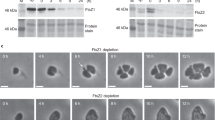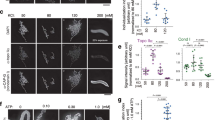Abstract
The bacterial septum-located DNA translocase FtsK coordinates circular chromosome segregation with cell division. Rapid translocation of DNA by FtsK is directed by 8-base-pair DNA motifs (KOPS), so that newly replicated termini are brought together at the developing septum, thereby facilitating completion of chromosome segregation. Translocase functions reside in three domains, α, β and γ. FtsKαβ are necessary and sufficient for ATP hydrolysis–dependent DNA translocation, which is modulated by FtsKγ through its interaction with KOPS. By solving the FtsKγ structure by NMR, we show that γ is a winged-helix domain. NMR chemical shift mapping localizes the DNA-binding site on the γ domain. Mutated proteins with substitutions in the FtsKγ DNA-recognition helix are impaired in DNA binding and KOPS recognition, yet remain competent in DNA translocation and XerCD-dif site-specific recombination, which facilitates the late stages of chromosome segregation.
This is a preview of subscription content, access via your institution
Access options
Subscribe to this journal
Receive 12 print issues and online access
$189.00 per year
only $15.75 per issue
Buy this article
- Purchase on Springer Link
- Instant access to full article PDF
Prices may be subject to local taxes which are calculated during checkout




Similar content being viewed by others
References
Rocha, E.P. Order and disorder in bacterial genomes. Curr. Opin. Microbiol. 7, 519–527 (2004).
Barre, F.-X. & Sherratt, D.J. Chromosome dimer resolution. in The Bacterial Chromosome (ed. Higgins, N.P.) 513–524 (ASM Press, Washington, DC, 2005).
Wang, X., Liu, X., Possoz, C. & Sherratt, D.J. The two Escherichia coli chromosome arms locate to separate cell halves. Genes Dev. 20, 1727–1731 (2006).
Blattner, F.R. et al. The complete genome sequence of Escherichia coli K-12. Science 277, 1453–1474 (1997).
Lesterlin, C., Mercier, R., Boccard, F., Barre, F.X. & Cornet, F. Roles for replichores and macrodomains in segregation of the Escherichia coli chromosome. EMBO Rep. 6, 557–562 (2005).
Ip, S.C.Y., Bregu, M., Barre, F.-X. & Sherratt, D.J. Decatenation of DNA circles by FtsK-dependent Xer site-specific recombination. EMBO J. 22, 6399–6407 (2003).
Lesterlin, C., Barre, F-X. & Cornet, F. Genetic recombination and the cell cycle: what we have learned from chromosome dimers. Mol. Microbiol. 54, 1151–1160 (2004).
Errington, J., Bath, J. & Wu, L.J. DNA transport in bacteria. Nat. Rev. Mol. Cell Biol. 2, 538–545 (2001).
Saleh, O.A., Perals, C., Barre, F.-X. & Allemand, J.-F. Fast, DNA-sequence independent translocation by FtsK in a single-molecule experiment. EMBO J. 23, 2430–2439 (2004).
Pease, P.J. et al. Sequence-directed DNA translocation by purified FtsK. Science 307, 586–590 (2005).
Bigot, S. et al. KOPS: DNA motifs that control E. coli chromosome segregation by orienting the FtsK translocase. EMBO J. 24, 3770–3780 (2005).
Levy, O. et al. Identification of oligonucleotide sequences that direct the movement of the Escherichia coli FtsK translocase. Proc. Natl. Acad. Sci. USA 102, 17618–17623 (2005).
Wang, X., Possoz, C. & Sherratt, D.J. Dancing around the divisome: asymmetric chromosome segregation in Escherichia coli. Genes Dev. 19, 2367–2377 (2005).
Yates, J. et al. Dissection of a functional interaction between the DNA translocase, FtsK, and the XerD recombinase. Mol. Microbiol. 59, 1754–1766 (2006).
Massey, T.H., Mercogliano, C.P., Yates, J., Sherratt, D.J. & Löwe, J. Double-stranded DNA translocation: structure and mechanism of hexameric FtsK. Mol. Cell 23, 457–469 (2006).
Ptacin, J.L., Nollman, M., Bustamante, C. & Cozzarelli, N.R. Identification of the FtsK-recognition domain. Nat. Struct. Mol. Biol., advance online publication 15 October 2006 (doi:10.1038/nsmb1157).
Gajiwala, K.S. & Burley, S.K. Winged helix proteins. Curr. Opin. Struct. Biol. 10, 110–116 (2000).
Aravind, L. et al. The many faces of the helix-turn-helix domain: transcription regulation and beyond. FEMS Microbiol. Rev. 29, 231–262 (2005).
Holm, L. & Sander, C. Searching protein structure databases has come of age. Proteins 19, 165–173 (1994).
Schwartz, T., Rould, M.A., Lowenhaupt, K., Herbert, A. & Rich, A. Crystal structure of the Za domain of the human editing enzyme ADAR1 bound to left-handed Z-DNA. Science 284, 1841–1845 (1999).
Safo, M.K. et al. Structure of the MecI repressor from Staphylococcus aureus in complex with the cognate DNA operator, mec. Acta Crystallograph. Sect. F. Struct. Biol. Cryst. Commun. 62, 320–324 (2006).
Aussel, L. et al. FtsK is a DNA motor protein that activates chromosome dimer resolution by switching the catalytic state of the XerC and XerD recombinases. Cell 108, 195–205 (2002).
Singleton, M.R. et al. Conformational changes induced by nucleotide binding in Cdc6/ORC from Aeropyrum pernix. J. Mol. Biol. 343, 547–557 (2004).
Ohnishi, T., Hishida, T., Harada, Y., Iwasaki, H. & Shinagawa, H. Structure-function analysis of the three domains of RuvB DNA motor protein. J. Biol. Chem. 280, 30504–30510 (2005).
Oganesian, L., Moon, I.K., Bryan, T.M. & Jarstfer, M.B. Extension of G-quadruplex DNA by ciliate telomerase. EMBO J. 25, 1148–1159 (2006).
Guzman, L.M., Belin, D., Carson, M.J. & Beckwith, J. Tight regulation modulation and high level expression by vectors containing the arabinose pBAD promoter. J. Bacteriol. 177, 4121–4130 (1995).
Subramanya, H.S., Arciszewska, L.K., Baker, R.A., Bird, L.E., Sherratt, D.J. & Wigley, D.B. Crystal structure of the site-specific recombinase, XerD. EMBO J. 16, 5178–5187 (1997).
Ferreira, H., Sherratt, D. & Arciszewska, L.K. Switching catalytic activity in the XerCD site-specific recombination machine. J. Mol. Biol. 312, 45–57 (2001).
Wüthrich, K. NMR of protein and nucleic acids (John Wiley & Sons, New York, 1986).
Neri, D., Szyperski, T., Otting, G., Senn, H. & Wüthrich, K. Stereospecific nuclear magnetic resonance assignments of the methyl groups of valine and leucine in the DNA-binding domain of the 434 repressor by biosynthetically directed fractional 13C labeling. Biochemistry 28, 7510–7516 (1989).
Kraulis, P.J., Domaille, P.J., Campbell-Burk, S.L., Van Aken, T. & Laue, E.D. Solution structure and dynamics of Ras p21·GDP determined by heteronuclear three- and four-dimensional NMR spectroscopy. Biochemistry 33, 3515–3531 (1994).
Cornilescu, G., Delaglio, F. & Bax, A. Protein backbone angle restraints from searching a database for chemical shift and sequence homology. J. Biomol. NMR 13, 289–302 (1999).
Brünger, A.T. et al. Crystallography & NMR system: a new software suite for macromolecular structure determination. Acta Crystallogr. D Biol. Crystallogr. 54, 905–921 (1998).
Recchia, G.D., Aroyo, M., Wolf, D., Blakely, G. & Sherratt, D.J. FtsK-dependent and -independent pathways of Xer site-specific recombination. EMBO J. 18, 5724–5734 (1999).
Firman, K. & Szczelkun, M.D. Measuring motion on DNA by the type I restriction endonuclease EcoR124 using triplex displacement. EMBO J. 19, 2094–2102 (2000).
Acknowledgements
Research was supported by the Medical Research Council (Cambridge) and the Wellcome Trust (Oxford). We acknowledge our collaborators in the N.R. Cozzarelli and C. Bustamante laboratories (University of California, Berkeley) and would like to dedicate this paper to N.R. Cozzarelli, who died while this work was in progress. We thank our Oxford colleagues, P. Antrobus for his help with mass spectroscopy and I. Grainge for valuable discussions. V.S. was supported by an Oxford University Clarendon Postgraduate Award.
Author information
Authors and Affiliations
Contributions
V.S., molecular biology and manuscript preparation. M.D.A., biochemistry, NMR and manuscript preparation. C.d.B., molecular biology. R.B., molecular biology. L.K.A., project direction and manuscript preparation. S.M.F., NMR. M.B., NMR. J.L., molecular biology, structural biology, project direction and manuscript preparation. D.J.S., project conception, project direction and manuscript preparation.
Corresponding author
Ethics declarations
Competing interests
The authors declare no competing financial interests.
Supplementary information
Supplementary Fig. 1
HSQC spectra of KOPS-FtsKγ interaction. (PDF 117 kb)
Supplementary Fig. 2
13C HSQC of E. coli FtsKγ. (PDF 98 kb)
Rights and permissions
About this article
Cite this article
Sivanathan, V., Allen, M., de Bekker, C. et al. The FtsK γ domain directs oriented DNA translocation by interacting with KOPS. Nat Struct Mol Biol 13, 965–972 (2006). https://doi.org/10.1038/nsmb1158
Received:
Accepted:
Published:
Issue Date:
DOI: https://doi.org/10.1038/nsmb1158
This article is cited by
-
vB_BcM_Sam46 and vB_BcM_Sam112, members of a new bacteriophage genus with unusual small terminase structure
Scientific Reports (2021)
-
Sequence-dependent catalytic regulation of the SpoIIIE motor activity ensures directionality of DNA translocation
Scientific Reports (2018)
-
Activation of Xer-recombination at dif: structural basis of the FtsKγ–XerD interaction
Scientific Reports (2016)
-
The Xer/dif site-specific recombination system of Campylobacter jejuni
Molecular Genetics and Genomics (2013)
-
Conjugal plasmid transfer inStreptomycesresembles bacterial chromosome segregation by FtsK/SpoIIIE
The EMBO Journal (2011)



